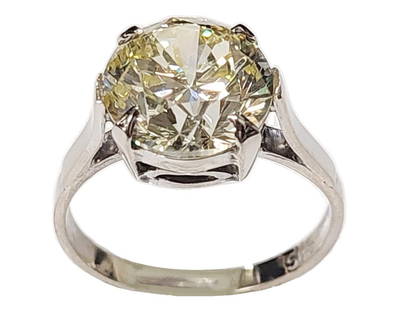
9th C. Viking Gold Bracteate Pendant w/ Triskele
Similar Sale History
View More Items in Necklaces & PendantsRelated Necklaces & Pendants
More Items in Necklaces & Pendants
View MoreRecommended Jewelry
View More




Item Details
Description
Northern Europe, Scandinavia, Viking or Norse culture, ca. 9th to 11th century CE. A breathtakingly beautiful pendant made from 89.85% to 94.64% gold (equivalent to 21K+ to 22K+) of a discoid form with a symmetrical composition featuring 5 filigreed triskeles with volutes at each terminus, surrounding a raised circular boss comprised of granules, with additional granules highlighting the overall composition. An integral suspension loop on top enables the pendant to be strung from a necklace strand and displayed as a wearable piece of ancient Viking finery! Size (pendant): 0.75" W x 1" H (1.9 cm x 2.5 cm); (necklace): 22.5" L (57.2 cm); quality of gold: 89.85% to 94.64% (equivalent to 21K+ to 22K+); total weight: 3.7 grams
Filigree and granulation are among the oldest goldsmithing techniques. The techniques involved include twisting silver or in this case gold wires and soldering incredibly tiny beads comprised of the same precious metal onto the surface of the piece of jewelry. This very complicated technique requires painstaking attention to detail that relatively few jewelers have ever mastered. Ancient civilizations such as the Mesopotamians, Greeks, and Etruscans developed the methodology; filigreed and granulated jewelry continued to be popular in the Roman empire, and was also sought after by the Slavs, Anglo-Saxons, and Vikings, remaining popular throughout the Middle Ages. In fact, modern jewelers still utilize these ancient goldsmithing techniques.
Interestingly, the overall form of this pendant is akin to that of a bracteate; bracteates were traditionally worn upon the chest and understood to be magical amulets. They were modeled on Roman medallions and sometimes were employed to confirm political alliances. Favorite iconography included horse-like creatures, figures most likely representing Odin, and apotropaic runes.
This piece has been searched against the Art Loss Register database and has been cleared. The Art Loss Register maintains the world's largest database of stolen art, collectibles, and antiques.
Provenance: private New York, USA collection; ex-Artemis Gallery; ex-private New York, New York USA collection
All items legal to buy/sell under U.S. Statute covering cultural patrimony Code 2600, CHAPTER 14, and are guaranteed to be as described or your money back.
A Certificate of Authenticity will accompany all winning bids.
PLEASE NOTE: Due to recent increases of shipments being seized by Australian & German customs (even for items with pre-UNESCO provenance), we will no longer ship most antiquities and ancient Chinese art to Australia & Germany. For categories of items that are acceptable to ship to Australia or Germany, please contact us directly or work with your local customs brokerage firm.
Display stands not described as included/custom in the item description are for photography purposes only and will not be included with the item upon shipping.
#167005
Filigree and granulation are among the oldest goldsmithing techniques. The techniques involved include twisting silver or in this case gold wires and soldering incredibly tiny beads comprised of the same precious metal onto the surface of the piece of jewelry. This very complicated technique requires painstaking attention to detail that relatively few jewelers have ever mastered. Ancient civilizations such as the Mesopotamians, Greeks, and Etruscans developed the methodology; filigreed and granulated jewelry continued to be popular in the Roman empire, and was also sought after by the Slavs, Anglo-Saxons, and Vikings, remaining popular throughout the Middle Ages. In fact, modern jewelers still utilize these ancient goldsmithing techniques.
Interestingly, the overall form of this pendant is akin to that of a bracteate; bracteates were traditionally worn upon the chest and understood to be magical amulets. They were modeled on Roman medallions and sometimes were employed to confirm political alliances. Favorite iconography included horse-like creatures, figures most likely representing Odin, and apotropaic runes.
This piece has been searched against the Art Loss Register database and has been cleared. The Art Loss Register maintains the world's largest database of stolen art, collectibles, and antiques.
Provenance: private New York, USA collection; ex-Artemis Gallery; ex-private New York, New York USA collection
All items legal to buy/sell under U.S. Statute covering cultural patrimony Code 2600, CHAPTER 14, and are guaranteed to be as described or your money back.
A Certificate of Authenticity will accompany all winning bids.
PLEASE NOTE: Due to recent increases of shipments being seized by Australian & German customs (even for items with pre-UNESCO provenance), we will no longer ship most antiquities and ancient Chinese art to Australia & Germany. For categories of items that are acceptable to ship to Australia or Germany, please contact us directly or work with your local customs brokerage firm.
Display stands not described as included/custom in the item description are for photography purposes only and will not be included with the item upon shipping.
#167005
Condition
Wearable as shown. Gold pendant is ancient, and necklace strand is modern. Subtle indentation on left side, otherwise intact and excellent. Beautiful patina throughout.
Buyer's Premium
- 24.5%
9th C. Viking Gold Bracteate Pendant w/ Triskele
Estimate $6,500 - $9,000
14 bidders are watching this item.
Shipping & Pickup Options
Item located in Louisville, CO, usOffers In-House Shipping
Local Pickup Available
Payment

TOP




















































































